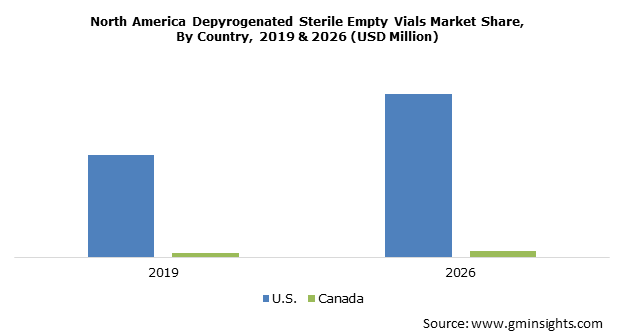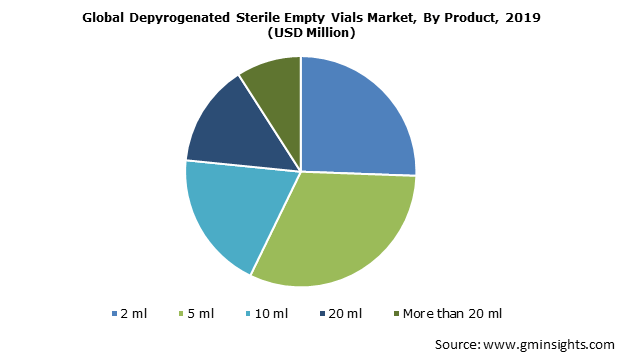Home > Healthcare > Medical Devices > Medical Supplies > Depyrogenated Sterile Empty Vials Market
Depyrogenated Sterile Empty Vials Market Analysis
- Report ID: GMI3058
- Published Date: Jan 2020
- Report Format: PDF
Depyrogenated Sterile Empty Vials Market Analysis
Increasing prevalence of infectious diseases worldwide will serve to be a major factor rendering positive impact on the market. According to UNAIDS, in 2018, around 37.9 million people across the globe were living with HIV, wherein, 1.7 million were newly infected. Rising number of people suffering from such infectious diseases will increase the demand for depyrogenated sterile empty vials for appropriate sample storage, thus, accelerating the industry growth. In addition, surge in the number of clinical labs for performing various medical and diagnostic tests will further favor the depyrogenated sterile empty vials market expansion.
Moreover, pharma packaging is progressively evolving in terms of security features as well as innovative designs. Government policies to encourage the development of advanced pharmaceutical packaging will serve to be another driver, accelerating the market progress. The primary, secondary and tertiary pharmaceutical packaging is undergoing self-transformation to minimize cost, reduce burden on logistic chain and improve visibility. Growing investments by several pharmaceutical and biopharmaceutical companies in R&D activities for development of innovative packaging solutions will encourage the depyrogenated sterile empty vials industry growth. However, inclination towards other parenteral packaging alternatives may restrain the market growth over the forthcoming years.
Depyrogenated sterile empty vials are segmented into 2 ml, 5 ml, 10 ml, 20 ml and more than 20 ml vials. 20 ml vials segment held around 14% market share in 2019 and is projected to show lucrative growth over the forecast period. Demand for clear 20 ml glass vials, pre-assembled with stopper and aluminium crimp seals, for efficient storage of parenteral formulations is on rise. Additionally, usage of 20ml vials for decanting and transportation of small amounts of solvents will escalate the demand for such vials in various clinical and research laboratories, thereby, fostering the market expansion.
Based on package technology, the depyrogenated sterile empty vials market is divided into glass and plastic vials. Glass vials market demand was valued over USD 650 million in 2019, owing to the advantages offered by glass vials over plastic including enhanced chemical durability and damage resistance. Moreover, glass vials enable pharmaceutical and biopharmaceutical companies to effectively deliver and store critical drug formulations. Increasing adoption of both molded and tubular depyrogenated sterile empty glass vials in chemical and biological reactions, plant cell culture, photobiological studies as well as sample collection and storage will accelerate market growth during the forthcoming years.
Compounding labs market accounted for significant revenue share in 2019 and is estimated to witness around 7.5% CAGR over the analysis period. Growing patient preference towards personalized medicine in developed economies will surge the demand for depyrogenated sterile empty vials in compounding labs. Personalised medication offered by compounding labs for corrective patient management results in improved health outcomes. Thus, growing demand for compounded medication that is not available commercially and is formulated for specific patient needs will prove beneficial for market progression.

North America held more than 35% revenue share in 2019 and is estimated to show considerable growth over the analysis period. Rigorous investments by pharma and biotech companies in R&D activities for developing innovative packaging will primarily drive the regional market growth.
U.S. market is poised to exceed USD 475 million by 2026. Market growth is attributed to government funding and technological progress in the booming pharmaceutical and biologics packaging business. Moreover, increasing number of clinical labs in the U.S. will accelerate the demand for depyrogenated sterile empty vials. Strong foothold of key industry players in the U.S. will further impact the regional market growth during the forecast period.

